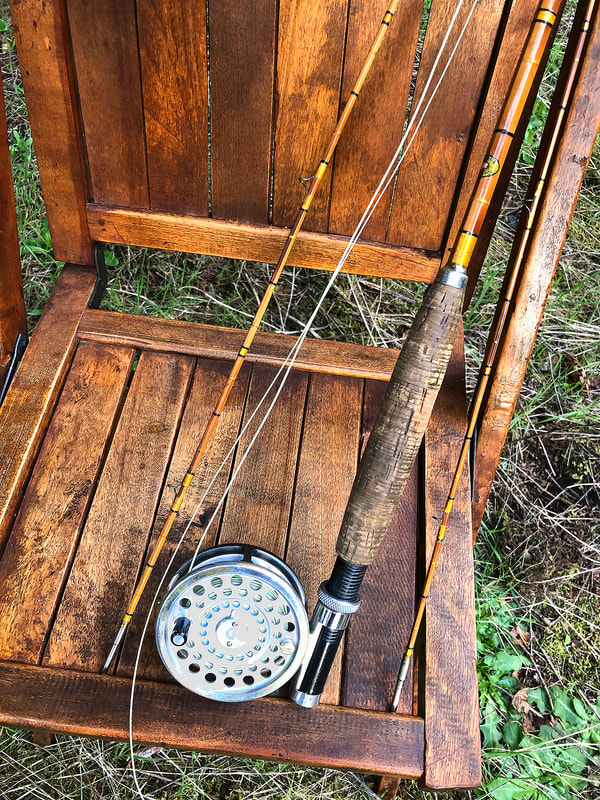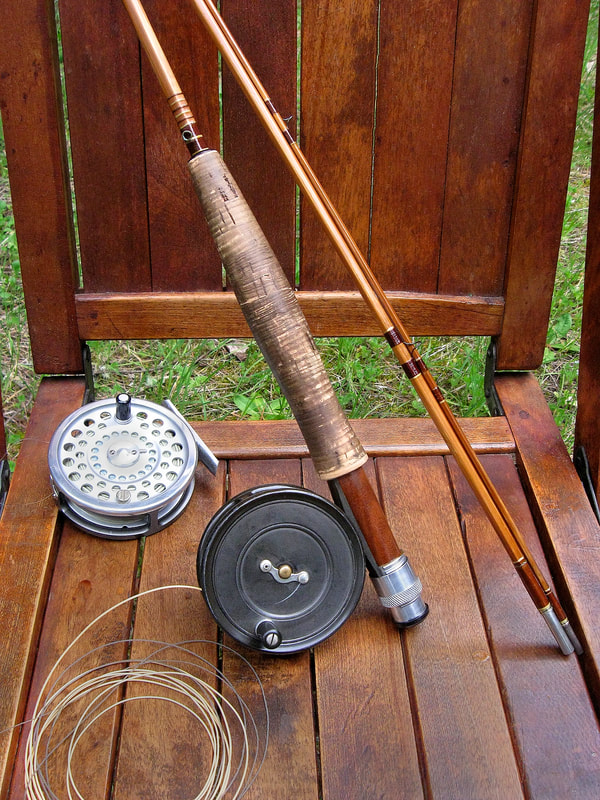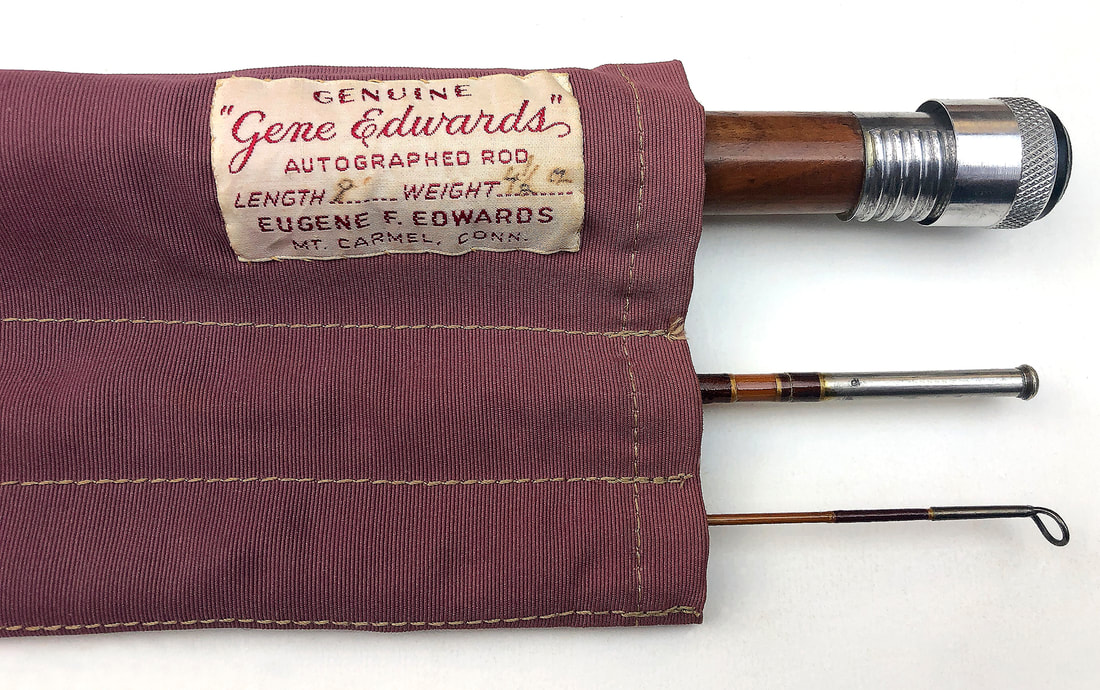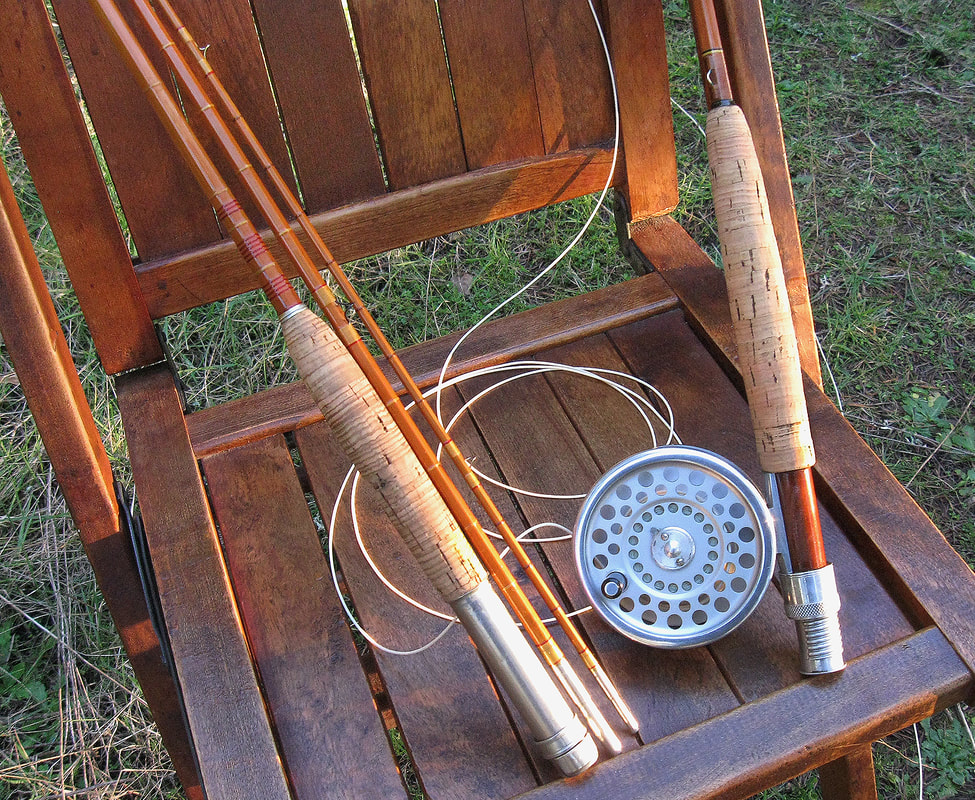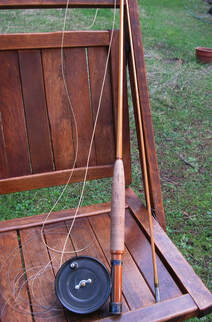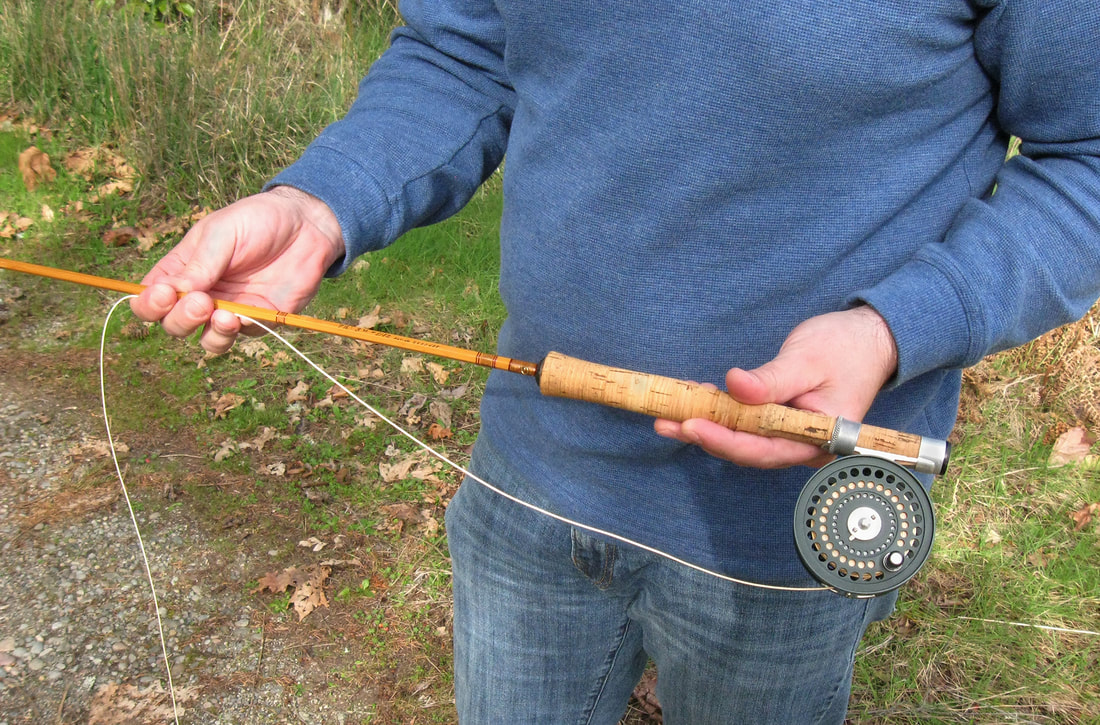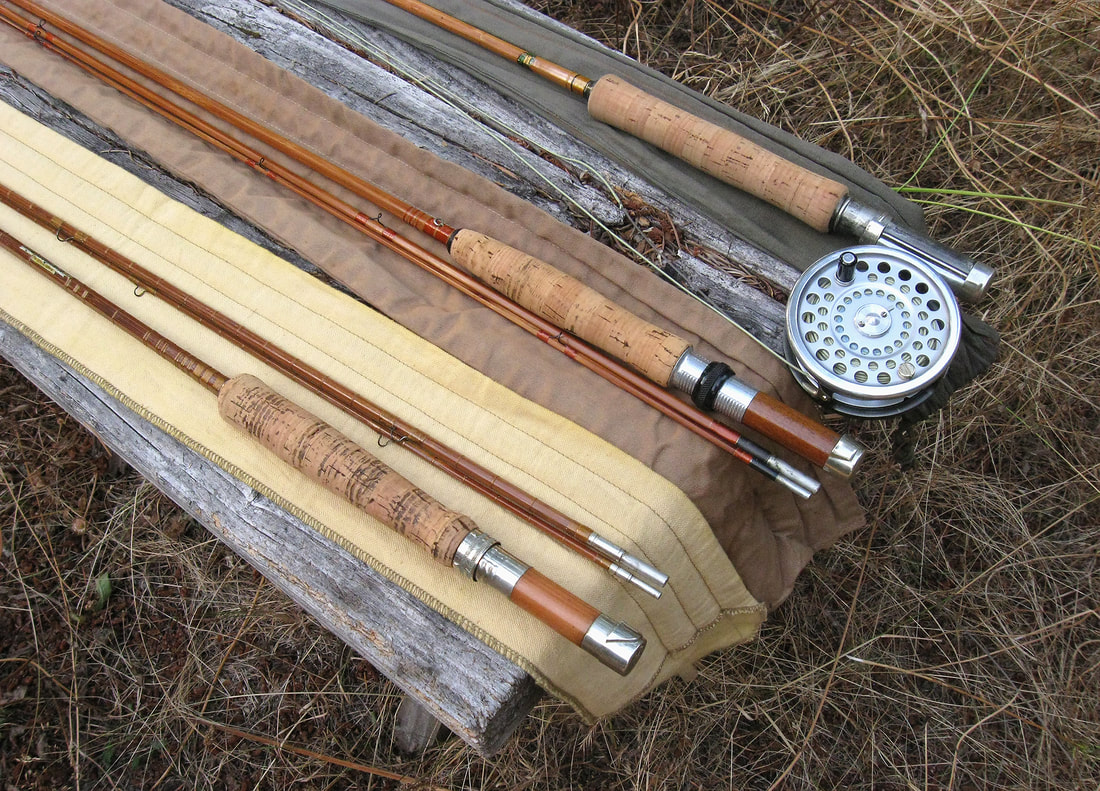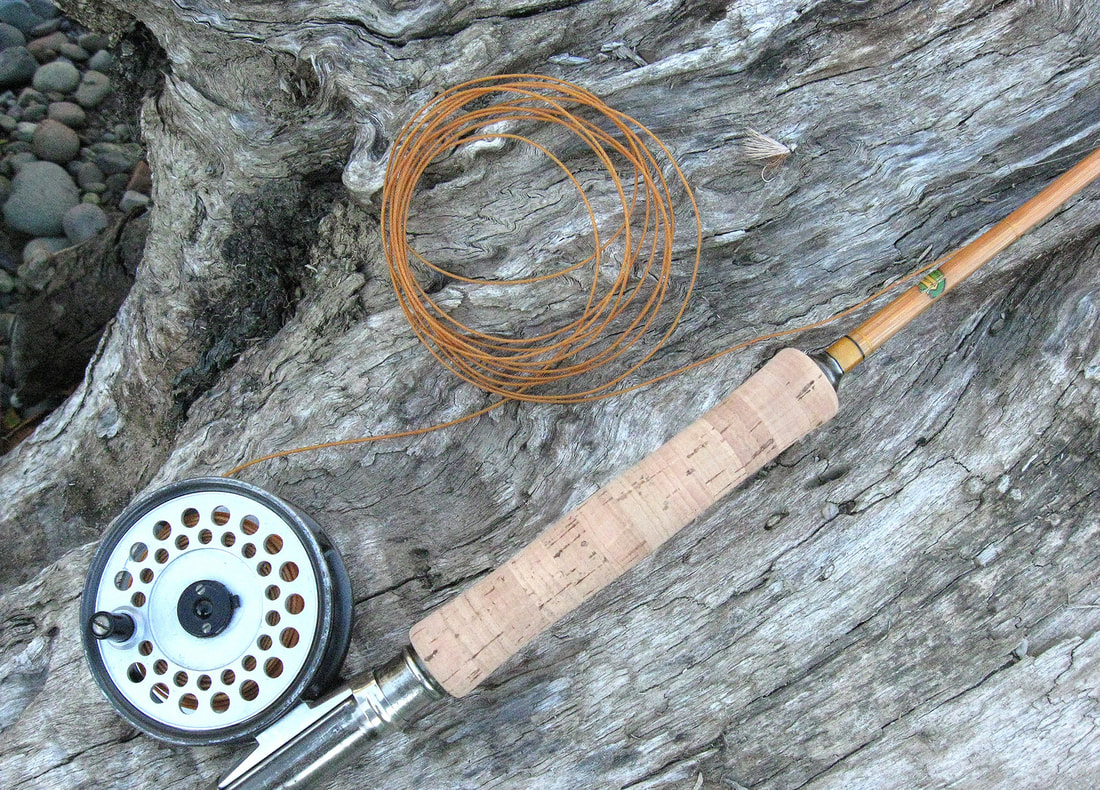Test Casting Rods...
Taking a restored bamboo rod back to the water completes the circle; test casting brings it part way there ...
|
|
Notes on Matching Rods & Lines
1. Best fly line weight for a rod depends on your normal 3. Every rod will cast a wider range of line weights than its
casting distances. numbered rating.
2. A difference of 5 ft of extended line changes effective 4. Line size designation is often not consistent nor reliable
line wt by a full line size! across manufacturers
[from 'Perfecting the Cast', Ed Jaworowski, 2020]
1. Best fly line weight for a rod depends on your normal 3. Every rod will cast a wider range of line weights than its
casting distances. numbered rating.
2. A difference of 5 ft of extended line changes effective 4. Line size designation is often not consistent nor reliable
line wt by a full line size! across manufacturers
[from 'Perfecting the Cast', Ed Jaworowski, 2020]
Recent Test Casting...
Montague 'Splitswitch' - 9 ft, 3/3 - circa 1930's 4-12-25
|
When a customer wrote to describe his treasured grandfather's rod as a 'Splitswitch', I was understandably confused... I have many Splitswitch models here, & all were the convertible type, w/ clunky large diameter reel seats, & a hole in the butt cap for inserting a heavy casting tip. When he sent photos of the decal w/ 'Splitswitch' clearly printed, I was still perplexed, thinking this must be a mislabeled 'Flipline'...
The rod had been left set up over the winter, & had acquired a bevy of sets in all sections. Could I straighten the rod? When the rod arrived, all I could do was gasp, "What a lovely rod!" With delicate flamed sections, full intermediates, 0.075" tips, & 10/16 ferrules, this was clearly not the usual Splitswitch! A quick check in Sinclair revealed that the Splitswitch was produced over a long period, & was originally an upper middle grade Montague, just below 'Fishkill' in the line up. After straightening the sections (& discovering the cane was very 'tender', requiring only brief mild heating to move), & rewrapping the damaged stripper & re-sealing other wraps, it was time for test casting... |
I assembled the newly straightened rod, & fitted the scrulock reel seat w/ SA Sys 6 reel & DT5F line
(406 brand, true to weight). Gingerly lengthening line, casts began w/ large loops, extending to 30, 40, then
50 feet. The full action rod was graceful in every way, & accomplished casts close in (10 -15 ft) with ease, owing to its fine tips.
Seeing if I could close the casting loops, I altered my cast from a relaxed stroke involving the full rod, to a more authoritative fore & aft stroke using the mid & butt sections to power the casts. Loops tightened nicely. Finally, even though on uneven grass, I experimented w/ several roll casts, & was rewarded when the rod effortlessly unrolled 40' of line.
Despite having full intermediate wraps, the rod sports a later Montague decal, & elaborate wrap pattern that varies from the usual Splitswitch's.
In his exhaustive chapter on Montague, Michael Sinclair sums up that Montague 'was consistent only in being inconsistent'. When we add that George Varney supervised rod building from 1915 to 1933, we shouldn't be surprised to find many more beautiful & graceful rods from this often overlooked manufacturer.
(406 brand, true to weight). Gingerly lengthening line, casts began w/ large loops, extending to 30, 40, then
50 feet. The full action rod was graceful in every way, & accomplished casts close in (10 -15 ft) with ease, owing to its fine tips.
Seeing if I could close the casting loops, I altered my cast from a relaxed stroke involving the full rod, to a more authoritative fore & aft stroke using the mid & butt sections to power the casts. Loops tightened nicely. Finally, even though on uneven grass, I experimented w/ several roll casts, & was rewarded when the rod effortlessly unrolled 40' of line.
Despite having full intermediate wraps, the rod sports a later Montague decal, & elaborate wrap pattern that varies from the usual Splitswitch's.
In his exhaustive chapter on Montague, Michael Sinclair sums up that Montague 'was consistent only in being inconsistent'. When we add that George Varney supervised rod building from 1915 to 1933, we shouldn't be surprised to find many more beautiful & graceful rods from this often overlooked manufacturer.
Gene Edwards 'De Luxe' - 8 ft, 4-1/2 oz - 3/2 - circa 1940's 4-26-24
|
A not-so-sunny spring afternoon was right for long overdue test casting of vintage Gene Edwards 'Autograph' rod, before sending it out to its new owner.
A 1940's Meek model 55 was paired with this 8 ft, 4-1/2 oz Gene Edwards 1940's Mt Carmel era rod, providing a period correct combination, as well as nice balance for this lightweight 'dry fly' action rod. Thinking "4 weight", I started w/ a DT4F SA (buckskin) line, true to wt. Line was extended from 15 feet to 20, 25, then out to 40-45 feet, w/ medium loops & delicate line control. Pushing further to 50-55 feet required shooting the light line, w/ some loss of line control. Very short casts required wrist action for the rod tip to lay out the short line & leader. Switching to a SA System 6 reel (slightly heavier) loaded w/ a DT5F '406' brand line (made by SA, wt. correct), the rod had a different feel. Short casts were prompt & true, while medium length casts were very smooth, loading the rod progressively w/ slightly narrower loops than w/ the 4 wt. Continuing on to 50 & 55 feet was almost effortless w/ rod loading & controlling the line at all stages (no need for shooting). |
Two 8-1/2 ft Payne's - 4 oz, 4.8 oz - 3/2 - circa 1917, 1930's - 3-5-22
A sunny afternoon provided a rare opportunity to test cast two vintage 8-1/2 ft Payne fly rods: an early '204' model, & a much earlier "EF Payne Rod". Both were made for R&D Folsom Arms Co, New York.
|
Early EF Payne was fitted w/ DT5F (406, true to weight). With its medium full "trout action", it was obvious this rod would give a very different casting performance from the later '204'.
As casts extended, the rod flexed well into it's mid section & top of butt section. Casts were very smooth, w/ medium well formed loops. At short distances, & out to 35 & 50 ft, the rod remained well balanced, loading & unloading in an easy relaxed rhythm. |
Payne 'Trout Action', ca. 1915-19
Length: 8-1/2' Wt: 4.0 oz w/ ni-silver slide band seat Ferrules: 10/16 sd Tip: 0.066" over-varnish Payne '204', ca. 1930's Length: 8-1/2' Wt: 4.8 oz w/ uplocking reel seat Ferrules: 10/16 sd Tip: 0.063" o.v. |
Payne '204' was fitted w/ DT6F (SA Supreme), after lackluster performance w/ DT5 & DT4 lines in a previous session. Funny thing is, many fly rods seem to ask for one line when waved or 'waggled' around, but actually loaded w/ line, they speak differently...
Rod tube labeled '204L', & rod weight & ferrule sizes all suggested a '204L'. This time the '204' loaded progressively as line was extended, first to 20', then 35', & finally out to a full 60'. Loops were easily controlled, as line flowed out smoothly. Unlike w/ the 4 & 5 wts, now the vintage Payne came into its own, balanced & responsive, a glowing credit to its renowned maker. |
Ron Kusse, 7 ft, 2-7/8 oz, 2/2, 1982 - 2-8-22
|
Following scarf of broken tip section, elegant & lightweight Ron Kusse rod was test cast to determine proper line weight, as well as security of newly scarfed tip (see 'Current Repairs' page).
The Kusse hang tag specifies #4 line, so casts started w/ DT4F (SA Ultra, ca 2000). Rod showed it's strength & power right off, despite its slender profile. Out to 50 - 60 feet the rod wasn't even breathing hard. Loops were tight, depending on casting stroke, & accuracy was excellent. Pulling the distance in to 15 feet, the slender tip flexed to send line & leader out smoothly. Switching to DT5F (406), the rod continued to perform well out to 45 feet, throwing larger loops due to my easing the casting stoke to allow for the heavier line. I concluded Kusse's original #4 specification was exactly right. |
Mortised Butt Antique Rod, likely Montague, 10 ft, ca 1900-1910 - 10-23-21
|
...Hemlock needles betray the season, while dry days still provide windows for test casting. Antique rod w/ Mortised butt & Montague style components was recently restored, w/ the owner's ultimate aim of fishing it. Originally 10 ft, the tip had suffered a 4" loss, leaving him a respectable 9 ft 8 in to ply his Maryland home waters.
A flexible tip & mid section suggested a DT5 might fit the bill. Using a Cortland DT5F Sylk, the rod laid out comfortable casts from 25 to 45 feet. Choking up on the grip, onto the mortised butt, helped balance the weight of the rod, as I shortened casts to 15 feet. The Sylk laid out nicely, despite only 15' of line beyond the tip top. With a feeling of power to spare, I judged the rod could easily reach out to 60, 70 feet & beyond, but given its length & the small size of the owner's home waters, I decided not to push this over 100-year-old rod to greater distances... more to come... |
Winston 'Leetle Feller' 7-1/2 ft, 3 oz, ca 1960's, San Francisco - 4-10-21
|
...This April, spring was in the air while only hints were visible on the ground, when Rich Floer visited, bringing his Winston 'Leetle Feller' for a long-delayed test casting session. Among these delicate rods from the San Francisco era of Winston, most of the 7-1/2 footers were 3-1/8 oz, rated for a 3 wt line. This rare example was scripted at 3 oz & is usually judged to take a 2 wt line.
more to come... |
Scottish Anderson Greenheart 9 ft, ca 1880 -1895 - 2-24-21
|
The first sunny day in weeks found me on the grass test casting 3 fly rods. However, it was the Scottish greenheart that created most of my excitement. Lithe & slender, it's dark finish & brass fittings glowed w/ a history I could only begin to understand.
Fitting the greenheart w/ a 1930's Meek reel, patterned after the Hardy Uniqua, was a nod to the rod's British roots. When I gingerly extended the #4 line (SA, DT, buckskin), the rod flexed deep into its solid wood handle. Remembering the owner had fractured its original wire tip top casting a #5 line [see Current Repairs], I wasn't taking any chances... Increasing casts to 25 feet, I quickly realized I would have to alter my usual casting stroke to synch w/ this rod. "Yes", the owner wrote me, "the slowness of the greenheart rods takes some getting used to. You have to pause a full 1-1/2 - 2 seconds between your back cast & forward cast." |
After checking to make sure the newly fashioned tip top was holding, I dared to fit a 5 wt (DT, Cortland Sylk) & carefully extended line. The rod flexed as before, but felt more loaded. At 40 ft, I found I could actually "shoot" a few feet of line through the wire loop tip top! It was plain to see, though, I had still more learning to do w/ my casting stroke to reap the benefits of greenheart...
...More to come |
Late Summer Test Casting - 9-7-20
|
A hat trick of 1920's -1930's 8-1/2 footers, all 5 weights, provided an enjoyable casting session, & a close comparison of rod action & casting performance.
In the company of two pedigreed EW Edwards', the 1931 Shakespeare, of still uncertain parentage, rose above the others w/ an almost perfect balance of authority, precision & delicacy. ...More to come |
Orvis Midge 7-1/2 ft, ca 1969 - 5-23-20 .... surprises!
(Orvis labeled 'HEG", equivalent to WF5F today)
 Recently restored Orvis Midge, 7-1/2 ft (1969) w/ protective wrap on cork for test casting
Recently restored Orvis Midge, 7-1/2 ft (1969) w/ protective wrap on cork for test casting
I've always abhored afixing line stickers to the outside of fine fly reels, where the remains remains for years if not decades. Today it would have helped!
I began testing the Orvis Midge* w/ a DT5F. I extended line as the rod flexed, loaded, & smoothly sent out casts to 55 ft. Shorter casts were smooth & controlled as well. Nice.
Now to try a DT4F... As I removed the spool to change lines, I glanced at the sticker on the inside flange - DT6F, Sci Anglers Supreme. What?!! Here was a rod that was rated by Orvis for "HEG" (WF5), & I was comfortably
casting a 6 wt DT, & out to distance too!!! [And this in the face of the common wisdom that 'Orvis rods cast better using a line one wt lighter than labeled'!]
Now to actually try the 5 weight (406**, DT5F) -- As I extended line the rod loaded comfortably, casting smoothly to 45, then out to 60 ft w/ no strain. I then brought casts back in to 30, then 20 ft, & still the rod performed beautifully. Very nice!
May as well try the 4 wt too, I thought... Changing to a Sci Anglers Ultra 3, DT4F, I extended line & noticed casting took more effort, the line felt 'lighter' in the air, & less controlled. Extending casts out to 50 ft w/ effort, I lost good control of casting loops, & accuracy suffered as well. Shorter casts were similarly less controlled. Hmm... Not really balanced.
Notes: *Orvis Midge (1969) tested has tip measuring 0.082"; comparable 1968 Midge has similar tip dimensions. Another
Midge (1963) from a 'Midge/Nymph' combination rod, however, has tips much finer, 0.066"; its owner happily
fishes it w/ a DT4F. It is likely that Orvis varied the tapers of their Midge over the many years it was produced.
**406 Fly Lines are produced by Sci Anglers for a small family-based company in Montana. They are true to
weight & have a slightly longer fine tip than many contemporary lines.
I began testing the Orvis Midge* w/ a DT5F. I extended line as the rod flexed, loaded, & smoothly sent out casts to 55 ft. Shorter casts were smooth & controlled as well. Nice.
Now to try a DT4F... As I removed the spool to change lines, I glanced at the sticker on the inside flange - DT6F, Sci Anglers Supreme. What?!! Here was a rod that was rated by Orvis for "HEG" (WF5), & I was comfortably
casting a 6 wt DT, & out to distance too!!! [And this in the face of the common wisdom that 'Orvis rods cast better using a line one wt lighter than labeled'!]
Now to actually try the 5 weight (406**, DT5F) -- As I extended line the rod loaded comfortably, casting smoothly to 45, then out to 60 ft w/ no strain. I then brought casts back in to 30, then 20 ft, & still the rod performed beautifully. Very nice!
May as well try the 4 wt too, I thought... Changing to a Sci Anglers Ultra 3, DT4F, I extended line & noticed casting took more effort, the line felt 'lighter' in the air, & less controlled. Extending casts out to 50 ft w/ effort, I lost good control of casting loops, & accuracy suffered as well. Shorter casts were similarly less controlled. Hmm... Not really balanced.
Notes: *Orvis Midge (1969) tested has tip measuring 0.082"; comparable 1968 Midge has similar tip dimensions. Another
Midge (1963) from a 'Midge/Nymph' combination rod, however, has tips much finer, 0.066"; its owner happily
fishes it w/ a DT4F. It is likely that Orvis varied the tapers of their Midge over the many years it was produced.
**406 Fly Lines are produced by Sci Anglers for a small family-based company in Montana. They are true to
weight & have a slightly longer fine tip than many contemporary lines.
Our Helper...

After completing repair or restoration at Bamboo Rod Works, we test cast each rod to check the ferrules, guide wraps, integrity of re-laminations, reel seat, & assess overall performance of the rod. We also try several line weights to assess which line properly balances the rod at different casting distances.
Happily we have lots of help! At the first sound of the unmistakable Hardy click, our dedicated helper comes running! Whether we're testing a 7 ft Leonard "Fairy Catskill" w/ a modern DT-4, an historic Edwards 8-1/2 ft trade rod w/ a refurbished vintage silk DT-5, or a 10 ft Montague Manitou "Dry Fly Salmon" w/ a WF-8, our assistant's gentle paws keep our fly lines well in hand...
Happily we have lots of help! At the first sound of the unmistakable Hardy click, our dedicated helper comes running! Whether we're testing a 7 ft Leonard "Fairy Catskill" w/ a modern DT-4, an historic Edwards 8-1/2 ft trade rod w/ a refurbished vintage silk DT-5, or a 10 ft Montague Manitou "Dry Fly Salmon" w/ a WF-8, our assistant's gentle paws keep our fly lines well in hand...
